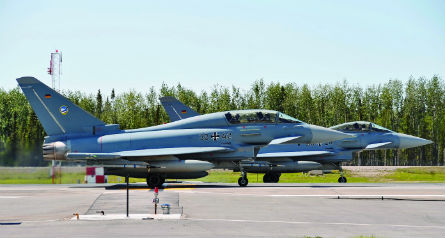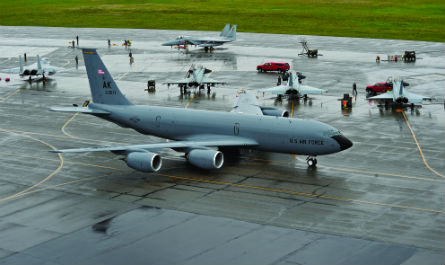The German air force's Fighter Wing 74 (JG74) brought eight of its Eurofighter combat aircraft to a Red Flag-Alaska exercise at Eielson AFB in Alaska during June, representing its first ever such deployment.
For the Luftwaffe, participation in the war games was needed to certify its Eurofighters for their NATO reaction force participation this November, says Col Andreas Pfeiffer, commander of JG74. The exercise was also aimed at helping to prepare the unit for a NATO force evaluation in March 2013, adds Pfeiffer.
He says that JG74's objectives at Red Flag-Alaska were to prove that Germany's aircraft can integrate with other allied aircraft and that it is ready for its NATO commitments.
Lt Col Marc Grune, the Luftwaffe's operations group commander, says his goal was "to get the German air force to a certain standard and prove that we can be able, in modern combat, to play a major role".
The war game afforded the Luftwaffe the chance to fly with other friendly air forces in a very large-scale exercise.
While the Germans often work with their neighbouring powers in Europe, such work cannot be performed to the scale and scope of a Red Flag.
"Our focus is the level of training we get here," Pfeiffer says. "We don't have that size of exercise - we don't have that level of training in Europe."
It is only through participating in these large-scale exercises that pilots can learn to fully integrate their aircraft with other allied aircraft types.
"For us, it's important, the whole thing, knowing the capabilities of the aircraft and how to integrate them," says Maj Marco Gumbrecht, JG74's chief of weapons and tactics. "Not only air-to-air, but air-to-ground."
Gumbrecht says that the Luftwaffe will always operate alongside allied aircraft, and as such, learning to work seamlessly with those other units is vital.
 |
|---|
| US Air Force Two out of eight Typhoons ready for takeoff |
JOINT OPERATION
In this case, the US Air Force's Lockheed Martin F-22 Raptors operated alongside the German Typhoons for the first time.
But there were also Japanese Boeing F-15Js and Polish Lockheed F-16C/D Block 52 aircraft present.
 |
|---|
| US Air Force A Boeing KC-135R Stratotanker taxis past German Typhoons and Japanese Boeing F-15Js during Red Flag |
All would be flown as friendly "Blue forces" during the exercise, according to Maj James Mixon, an exercise planner with the 353rd Combat Training Squadron. One of the USAF's goals was to teach the visiting forces how to interact with the stealthy fifth-generation Raptor, he says.
USAF F-16s and Fairchild Republic A-10 Thunderbolt II ground-attack aircraft also participated in the exercise. The US Navy had originally been expected to contribute Boeing EA-18G Growlers to the exercise, but these were called away for operational missions, says USAF Brig Gen James Post, commander of the 354th Fighter Wing, which hosts the exercise. The same was true of the USAF 18th Wing's active electronically scanned array radar-equipped F-15C Eagles.
The friendly forces were not limited to other fighters, with airborne command and control aircraft from Australia, Japan and NATO also having participated, along with transports and tankers from multiple nations.
On the opposing "Red" side, the USAF's elite 18th Aggressor Sqn, based at Eielson AFB, flew its Block 30 F-16 fighters. While these aircraft are not the latest version of the venerable fighter, the pilots and air controllers train full-time to provide realistic threat presentations of enemy aircraft. "How they replicate other aircraft is unique," Gumbrecht says.
For this Red Flag-Alaska, the 18th Aggressors replicated the Russian Sukhoi Su-27/30 and Chinese Chengdu J-10. They also simulated enemy electronic attacks using jamming pods carried by their F-16s. The aggressors ramped up the level of difficultly over several days to reach a crescendo.
Mixon, who also flies as an aggressor, says that while the level of difficulty can be intense, the enemy threat level is designed to teach, but not overwhelm.
Hence, enemy skill levels presented by the Aggressors at Red Flag are not as intense as at the USAF Weapons School mission employment phase, he says.
Because the Luftwaffe's goal was to prove the Typhoon's abilities as a fighter, the service took the opportunity to test new software modifications at Red Flag-Alaska. The idea was to bring the German aircraft up to the same standards as the UK Royal Air Force's Typhoons, Grune says. The RAF's squadrons have traditionally been on the leading edge of fully exploiting the fighter's capabilities, for example during last year's NATO-led operation over Libya.
 |
|---|
| US Air Force A Typhoon takes off from Eielson AFB |
"We came here for 'Distant Frontier' for a warm-up programme to test the systems," Grune says, referring to a series of manoeuvres flown with the aggressor unit before the main exercise started. "We adjusted the Eurofighter with some new systems, which we had never used before."
The biggest change was to the aircraft's Euroradar Captor sensor's software, which was vastly improved, Grune says. New radio, mission data and countermeasures software systems were also added, along with other, classified modifications.
Currently, the adaptations are found only on the eight German Eurofighters deployed to Eielson, with the last aircraft having been upgraded on the flight line at the Alaska base.
But Grune says the biggest change was not to the Typhoon's hardware or software, but to the Luftwaffe's mentality for using the aircraft. "Why is the British air force, for example, so superior with the Eurofighter and we are not?" he asks. "Simply because our force didn't put the focus on certain areas."
The Luftwaffe's mentality began to shift only towards the end of 2011 and the beginning of this year, he says. It was only when the Luftwaffe visited Eielson AFB as part of its Red Flag preparations that the Germans decided to prepare for the exercise as if it were real combat.
MULTIROLE MACHINE
Currently, Germany's Eurofighters are geared purely towards the air-to-air role. That must change, with employing the type as a multi-role machine being the only way of fully utilising its capabilities, Grune says. Once its aircraft receive those added capabilities, it should take about two years to train crews to fully use them in those new roles, he adds.
As part of the Distant Frontier exercise, F-22s from the USAF's 525th Fighter Squadron faced off against the German fighters in visual-range basic fighter manoeuvres (BFM) combat training.
While Grune does not directly say that the Eurofighters emerged as the overall victors, he strongly implies it.
"I put out some whiskey. If they come back with some good performances, and if you know what the goal is from a BFM setup, and you achieve that, then I will pay you whiskey," he says. "And I paid quite a lot of whiskey."
That account, however, is strongly disputed by USAF sources flying the F-22. "It sounds as though we have very different recollections as to the outcomes of the BFM engagements that were fought," one Raptor pilot says.
USAF sources say that the Typhoon has good energy and a pretty good first turn, but that they were able to outmanoeuvre the Germans due to the Raptor's thrust vectoring. Additionally, the Typhoon was not able to match the high angle of attack capability of the F-22. "We ended up with numerous gunshots," another USAF pilot says.
 |
|---|
| Lockheed Martin F-22s faced off against German fighters |
Regardless of their differing accounts, the USAF was grateful for the chance to train with the Luftwaffe. "We optimise the opportunities we get to participate in dissimilar air combat training, as those opportunities are all too rare," says Lt Col Paul Moga, commander of the 525th Fighter Squadron. "Our recent BFM hops with the German air force Typhoons were outstanding. While certain uncontrollable factors such as weather and manoeuvring limitations did not allow for full-up engagements, it is suffice to say that there was much learning across the board. The details of each set-up are privy only to the pilots that flew them, as that is the sacred standard among fighter pilots. One thing is for certain - Raptors and Typhoons are a lethal combination."
Grune says that the Raptor's advantage lies in its stealth and ability to dominate air-to-air fights from beyond visual range. That is not disputed by USAF sources.
"Its unique capabilities are overwhelming from our first impressions in terms of modern air combat," Pfeiffer says. "But once you get to the merge, which is only a very small spectrum of air combat, in that area the Typhoon doesn't have to fear the F-22 in all aspects."
The Typhoons were stripped of their external fuel tanks and slicked off as much as possible before the encounter with the Raptors, says Grune, who adds that in that configuration, the Typhoon is an "animal".
Pfeiffer notes that the Eurofighter has better acceleration and can out-climb the F-22. Additionally, he says that the Raptor sinks when it is using its thrust vectoring capabilities, although one USAF source says he is skeptical of the German claims.
Overall, Grune says the two aircraft are closely matched in the visual range arena, but Pfeiffer says the Typhoon is the superior dogfighter.
Source: Flight International



















